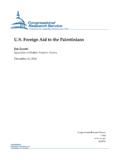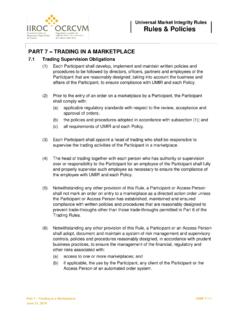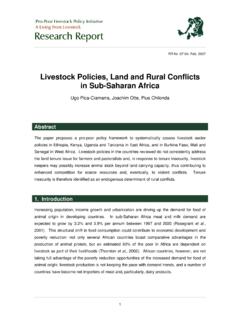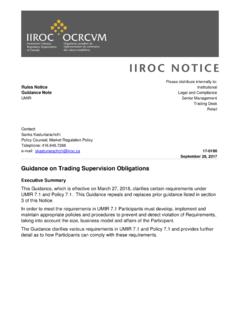Transcription of U.S.-Mexico Economic Relations: Trends, Issues, …
1 Economic relations : trends , Issues, and Implications M. Angeles Villarreal Specialist in International Trade and Finance March 27, 2018 Congressional Research Service 7-5700 RL32934 Economic relations : trends , Issues, and Implications Congressional Research Service Summary The Economic and trade relationship with mexico is of interest to policymakers because of mexico s proximity to the United States, the extensive trade and investment relationship under the North American Free Trade Agreement (NAFTA), and the strong cultural and Economic ties that connect the two countries. Also, it is of national interest for the United States to have a prosperous and democratic mexico as a neighboring country.
2 mexico is the United States third-largest trading partner, while the United States is, by far, mexico s largest trading partner. mexico ranks third as a source of imports, after China and Canada, and second, after Canada, as an export market for goods and services. The United States is the largest source of foreign direct investment (FDI) in mexico . NAFTA has been in effect since 1994. Most studies show that the net Economic effects of NAFTA on both countries have been small but positive, though there have been adjustment costs to some sectors within both countries. Much of the bilateral trade between the United States and mexico occurs in the context of supply chains as manufacturers in each country work together to create goods.
3 The expansion of trade has resulted in the creation of vertical supply relationships, especially along the border. The flow of intermediate inputs produced in the United States and exported to mexico and the return flow of finished products greatly increased the importance of the border region as a production site. manufacturing industries, including automotive, electronics, appliances, and machinery, all rely on the assistance of Mexican manufacturers. The 115th Congress faces numerous issues related to trade and investment relations . The Administration of Donald J. Trump is in the process of renegotiating NAFTA, and President Trump has repeatedly stated that he may decide to withdraw from the agreement.
4 Congress may wish to consider policy issues regarding the renegotiation, the ramifications of possibly withdrawing from NAFTA, how it may affect the economy, and the strategic implications of the upcoming presidential elections in mexico . It may also wish to examine the congressional role in the renegotiation, as well as the negotiating positions of mexico and Canada. mexico has stated that if negotiations are not favorable to the country, it may seek to broaden negotiations to include security, counter-narcotics, and transmigration issues, or it also may choose to withdraw from the agreement. Congress may also wish to address issues related to the withdrawal from the proposed Trans-Pacific Partnership (TPP) free trade agreement among the United States, Canada, mexico , and 9 other countries.
5 Some observers contend that the withdrawal from TPP could damage competitiveness and Economic leadership in the region, while others see the withdrawal as a way to prevent lower cost imports and potential job losses. Congress also may maintain an active interest in ongoing bilateral efforts to promote Economic competitiveness, increase regulatory cooperation, and pursue energy integration. Under the High Level Economic Dialogue (HLED), which was first launched in September 2013, the United States and mexico are striving to advance Economic and commercial priorities through annual meetings at the Cabinet level that also include leaders from the public and private sectors.
6 Another bilateral initiative that may be of interest to policymakers is the High-Level Regulatory Cooperation Council (HLRCC), which is intended to help align regulatory principles. In addition, the two countries have a bilateral border management initiative under the Declaration Concerning 21st Center Border Management. Economic relations : trends , Issues, and Implications Congressional Research Service Contents Introduction .. 1 Economic relations .. 1 Trade .. 2 Top Imports and Exports .. 4 Bilateral Foreign Direct Investment .. 4 Manufacturing and Supply Chains .. 6 mexico s Export Processing Zones.
7 7 Maquiladoras and NAFTA .. 8 Worker Remittances to mexico .. 8 Bilateral Economic Cooperation .. 9 High Level Economic Dialogue (HLED) .. 9 High-Level Regulatory Cooperation Council .. 10 21st Century Border Management .. 10 North American Leaders Summits .. 11 The Mexican 11 Informality and Poverty .. 12 Structural and Other Economic Challenges .. 13 Energy .. 14 mexico s Liberalization Efforts .. 15 Comprehensive and Progressive Trans-Pacific Partnership (CPTPP) Agreement .. 15 mexico s Free Trade Agreements .. 15 NAFTA .. 16 NAFTA Renegotiation .. 16 Possible Effect of Withdrawal from NAFTA .. 17 Selected Bilateral Trade Disputes.
8 18 Dolphin-Safe Tuna Labeling Dispute .. 18 Dispute over Labeling Provisions .. 19 WTO Tuna Dispute 19 Sugar Disputes .. 21 2014 Mexican Sugar Import Dispute .. 21 Sugar and High Fructose Corn Syrup Dispute Resolved in 2006 .. 22 Country-of-Origin Labeling (COOL) .. 23 NAFTA Trucking issue .. 24 Bush Administration s Pilot Program of 2007 .. 25 mexico s Retaliatory Tariffs of 2009 and 2010 .. 26 Obama Administration s 2011 Pilot Program .. 27 Mexican Tomatoes .. 28 Policy Issues .. 29 NAFTA .. 29 Possible NAFTA Withdrawal .. 30 Bilateral Economic Cooperation .. 31 mexico s 2018 Presidential Elections and Perspective.
9 31 Outlook .. 33 Economic relations : trends , Issues, and Implications Congressional Research Service Figures Figure 1. Trade with mexico : 1999-2016 .. 3 Figure 2. and Mexican Foreign Direct Investment Positions .. 6 Figure 3. Remittances to 9 Figure 4. GDP Growth Rates for the United States and mexico .. 12 Figure A-1. Map of mexico .. 34 Tables Table 1. Key Economic Indicators for mexico and the United States .. 2 Table 2. Imports from mexico : 2013-2017 .. 5 Table 3. Exports to mexico : 2013-2017 .. 5 Table 4. MFN Tariffs for NAFTA Countries .. 30 Appendixes Appendix. Map of mexico .
10 34 Contacts Author Contact Information .. 34 Acknowledgments .. 34 Economic relations : trends , Issues, and Implications Congressional Research Service 1 Introduction The bilateral Economic relationship is of key interest to the United States because of mexico s proximity, the extensive cultural and Economic ties between the two countries, and the strong Economic relationship with mexico under the North American Free Trade Agreement (NAFTA).1 The United States and mexico share many common Economic interests related to trade, investment, and regulatory cooperation. The two countries share a 2,000-mile border and have extensive interconnections through the Gulf of mexico .















